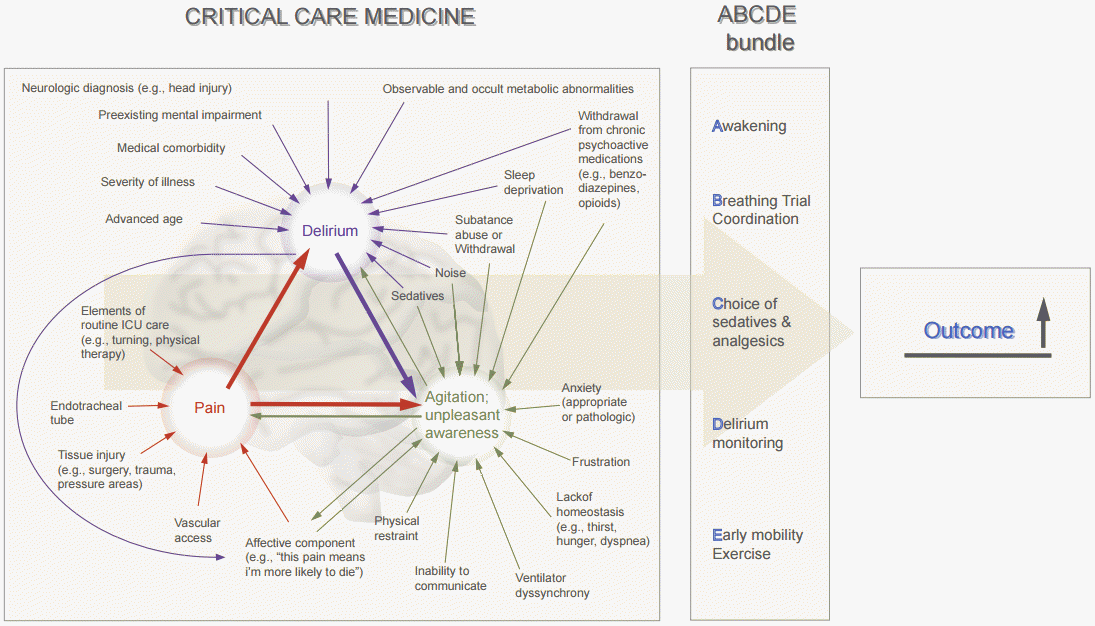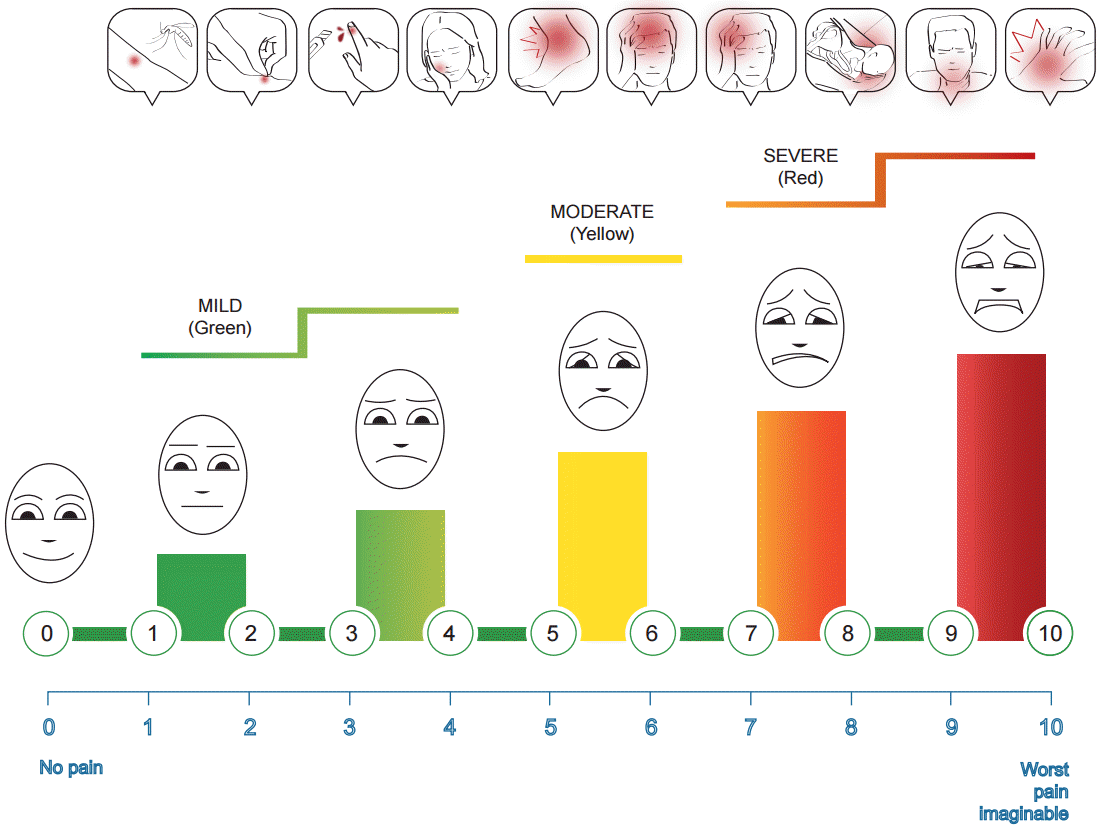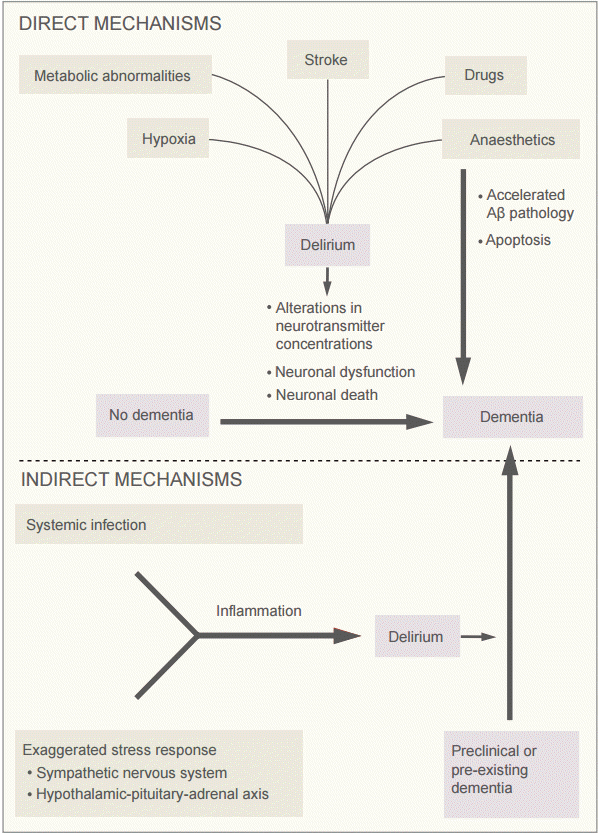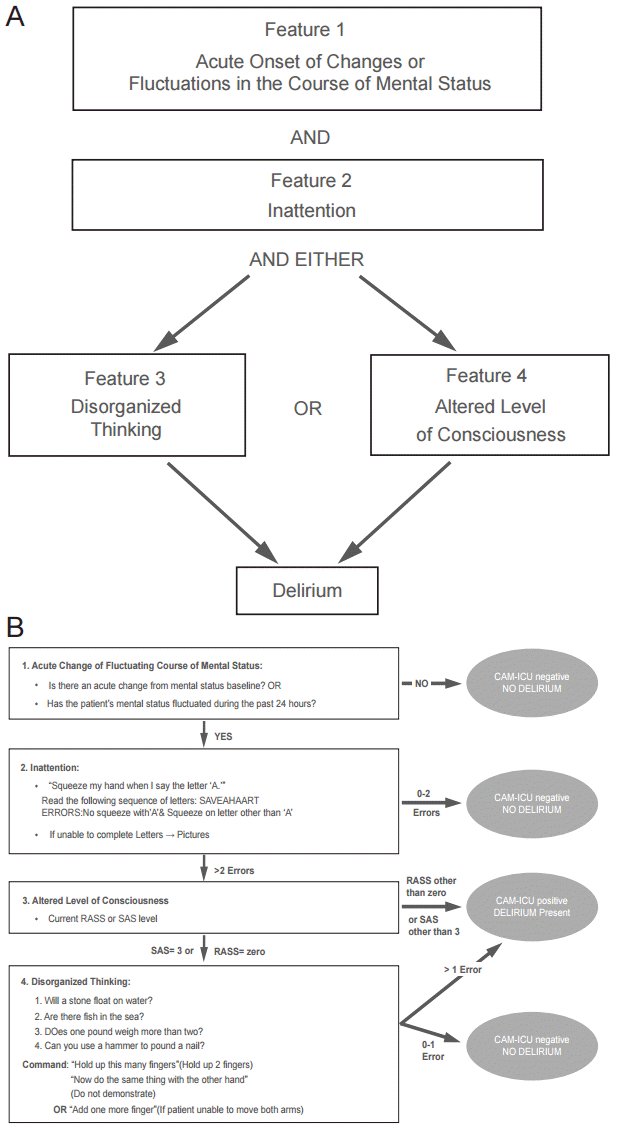통증, 초초 그리고 섬망
Abstract
Pain, Agitation/sedation, and Delirium (PAD) are frequent complications of critical illness and are associated with poor outcome and even impending dementia. In the setting of the general or neurological intensive care unit, pain and agitation can be ignored because these patients are often under special situations, such as decreased mentality, mechanical ventilation, administration of various sedatives, and physical restraint. In addition, they frequent present with clinically significant delirium. We focused on the pathophysiological integration of PAD by targeting outcomes, detection and monitoring, and management strategies using the ‘ABCDE care bundle’.
Key Words: Pain; Agitation; Delirium; Prevention; Treatment
서 론
한 연구에서 중환자실에 입원한 환자가 기억하고 있는 경험 중 기도 내 삽관으로 인한 ‘통증’은 가장 흔한 것이었다[ 1]. 또한 중환자실의 환자들은 다양한 원인으로 발생하는 ‘초초’로 인해 갑작스럽게 기도삽관튜브나 정맥주사를 스스로 빼기도 하여 중환자실에서 적지 않은 문제를 야기한다. 이러한 결과는 환자에게 부정적인 예후를 가져올 수 있고 이를 조절하기 위한 진정제의 과도한 사용으로 부작용이 발생할 수 있다[ 2]. 중환자실에서 환자에게 평안함과 안전을 제공해야 한다는 궁극적 목적은 통증과 진정을 위한 약물적-비약물적 방법의 체계적 도입이라는 수식으로 귀결되고 있다[ 3]. 이러한 방법들은 기계환기기를 사용하고 있는 중환자에게 편안하게 숨을 net쉴 수 있게 하고 치료예후를 항상시키는 것으로 알려져 있다. 특히 뇌의 기질적 문제를 담당하고 있는 신경계 중환자실에서는 산소와 포도당만을 사용하는 뇌의 특성 때문에 ‘통증과 초초’는 뇌압상승과 뇌 대사에 직접적으로 영향을 줄 수 있어 이를 세밀하게 조절하는 것은 더욱 중요할 수 있다[ 4]. 또한 다양한 원인으로 발생할 수 있는 ‘섬망’은 중환자실에 입원하는 환자의 이환율(morbidity)과 사망률(mortality)에 밀접한 관계가 있다[ 5, 6]. 이처럼 중환자실에서 흔히 발생하는 통증-초초-섬망(PAD: pain, agitation, delirium)은 서로 직 ∙ 간접적으로 관계하며 환자의 예후에 직-간접적으로 영향을 주는 조절 가능한 요소라 하여 ‘중환자실 3요소(Intensive Care Unit triad, ICU triad)’라고 불리고 있다( Fig. 1) [ 7]. 따라서 세 가지 요소를 평가하고 조절하는 것은 중환자의 예후를 호전시키며 환자의 행동에 영향을 받는 보호자 및 치료진의 부담을 경감시킬 수 있다. 본 종설에서는 중환자실 3요소인 통증-초초-섬망을 선별하는 방법과 이들의 부정적 결과물로 생각할 수 있는 섬망의 기전을 기술하고 이러한 환자들 치료하기 위한 중재적으로 사용되는 개념인 ‘ABCDE 다발’에 대해 기술하려고 한다[ 8].
본 론
1. 통증(pain)
중환자실 환경은 소음, 지속되는 조명, 낯선 의료진 등으로 환자에게는 정서적으로 신체적으로 좋지 않은 환경을 제공하게 된다. 게다가 중환자는 다양한 신체손상, 기관 내 삽관, 기계환기기 및 혈관 내 혹은 방광-위장 내 카테터 등 통증과 초초감을 발생시키기 쉬운 요소를 근본적으로 많이 가지고 있게 된다[ 3]. 연구에 의하면 적절한 진통제 투여는 산소소비량이 15% 정도를 경감시킬 수 있고[ 9], 뇌수술 후 혈압의 상승도 적절한 진통제의 투여에 의해 조절되며 이는 항고혈압약을 사용하는 것보다 더 효과적일 수 있다고 알려져 있다. 특히, 신경계 중환자실에서는 뇌 문제로 발생한 일차질환의 특성과 환자의 의식에 영향을 주고 의식을 깨워놔야 신경학적 판단을 할 수 있다는 치료진의 마음 등으로 적절한 의식수준의 정도가 환자마다 천차만별이므로 일반 중환자실보다 본 문제는 더욱 복잡하다고 할 수 있다. 따라서 진통제나 진정제가 너무 과도하게 투여되거나 그 반대로 너무 적게 투여될 수 있다. 이로 인한 합병증인 과도한 호흡억제, 기계환기기의 빠른 제거 실패, 중환자실 다발신경근육위축병 등이 발생할 수 있고, 신경계에 특별하게 발생하는 약물의 금단현상, 우울증, 외상후스트레스장애 등도 야기할 수 있다. 중환자실 3 요소 중 가장 먼저 통증의 관리가 우선시되며, 우선 환자의 의식이 있는 경우에는 통증이 없는 경우에 0점, 가장 극심한 통증을 10점으로 하여 수치적으로 통증을 측정할 수 있는 Numeric Rating Scale (NRS)을 이용하여 환자의 통증을 평가하고 중등도 이상으로 여겨지는 NRS가 4점 이상인 경우 적극적 조치가 필요한 것으로 간주되고 있다( Fig. 2) [ 10]. 환자가 통증을 스스로 표현할 수 없는 경우에는 환자의 행동을 관찰해 통증의 정도를 평가하며 중환자실에서 흔히 사용되는 방법은 Behavioral Pain Scale (BPS)와 Critical-Care Pain Observation Tool (CPOT)가 사용된다( Table 1) [ 11]. BPS의 경우 크게 세 가지 기준으로 통증을 평가하며 6점 이상인 경우에 적극적으로 통증 조절이 필요하다고 여기고 있다. CPOT는 5가지 항목으로 구성돼 있으며 3점 이상인 경우 통증 조절이 필요하다. 이러한 방식은 환자의 활력징후, 얼굴표정, 신체적 움직임, 기계호흡순응도 등을 함께 고려하여 환자의 통증을 추측하여 기계호흡 하에서도 적용시킬 수 있다. 미국 2013년 진료지침은 중환자실에 입원한 성인 환자들을 대상으로 통증 발생여부에 대해 주기적 관찰을 권고하고 있다. 환자의 통증을 감소시키면 폐 합병증, 섬망, 심부 혈관 혈전증의 발생을 감소시킬 수 있다는 보고가 있었다[ 3].
2. 초초(agitation) 및 진정(sedation)
중환자의 예후호전을 위해 환자의 평안함과 환자의 안전을 증진시키려는 시도로 다양한 약물적-비약물적 방법이 여러 나라의 진료지침에 체계적으로 도입되고 있다[ 11]. 환자가 초초함을 보일 때 적절한 조치를 취하지 않으면 난동상태가 일어나거나 환자와 기계환기기의 부조화가 일어날 수 있다. 반대로 지나친 진정을 유도하면 기계환기 및 중환자실에 체류하는 기간이 길어지게 되고 심부혈관혈전증 및 기계환기기 관련 폐렴 등의 발생이 증가한다. 따라서 전통적으로 중환자의 스트레스 수준을 줄이기 위해 과거 진정제를 강하게 사용하여 치료하던 경향이 최근 진정제의 사용량을 줄이고 중환자실 체류시간을 줄이기 위해 ‘최소진정방법’이 선호되고 있다[ 2]. 앞서 언급한 적절한 통증 조절 후, 다음 단계로 진정상태에 대한 객관적 평가가 필요하며 이의 적절한 조절이 필요하다고 할 수 있다. 중환자실에서 자주 사용되는 평가 방법으로는 Richmond Agitation Sedation Scale (RASS) 및 Sedation-Agitation-Scale (SAS)이 있다( Table 2). 기계환기기 치료를 받는 환자에서 적절한 진정 척도는 RASS -2에서 0점 SAS 3-4점 사이가 추천되고 있다.
3. 섬망(delirium)
섬망은 인지기능의 변동과 주위집중감소가 의식저하 또는 체계적이지 못한 생각과 더불어 비교적 갑작스럽게 발생하는 뇌의 부전상태로 간주되고 있다. 섬망의 발생기전은 (1) 중추에서 흥분성 역할을 하는 도파민 및 카테콜라민 등의 스트레스 호르몬의 기능적 증가, (2) 중추에서 억제성 역할을 하는 가바(GABA) 및 아세틸콜린 등의 기능적 감소, (3) 전신 및 중추 염증에 의한 기질적 뇌 기능 저하 등의 가설이 있고 이 요소들의 조합에 의해 발병한다고 알려져 있다( Fig. 3) [ 12- 14]. 섬망은 치매, 중추신경계질환, 알코올중독, 고령 등의 환자에서 발생할 가능성이 높으며, 위험인자로는 전해질불균형, 발열, 패혈증, 약물, 빈혈, 고혈압 등이 있다. 섬망의 유형에는 활동과잉형(hyperactive), 활동저조형(hypoactive), 혼합형(mixed) 등이 있으며, 활동과잉형인 경우 환자 관리가 어렵고 활동저조형은 일반적으로 예후가 좋지 않고 눈에 잘 띄질 않아 진단이 늦어지는 경향이 있다. 따라서 진단은 이러한 두 가지 형태를 감별할 수 있도록 설계되어 있다[ 11]. 섬망은 신경계 중환자실뿐 아니라 내과계 혹은 외과계 중환자실에서 흔히 접하게 되고, 중환자실에서 유병률은 30%에 달하고 기계환기를 하고 있는 환자에서는 60-80%까지 보고되고 있다[ 15]. 일반적으로 섬망 환자는 예후가 매우 저조한 것으로 알려지고 있고 전향적으로 진행한 코호트 연구에 따르면 섬망이 있는 환자는 그렇지 않은 환자보다 사망률이 현저히 높았다[ 11, 16]. 섬망의 진단 방법에 대해서는 CAM-ICU(confusion assessment method for the ICU, Fig. 4), ICDSC(Intensive Care Delirium Screening Checklist, Table 3) [ 11, 17] 등이 사용된다. CAM-ICU 에서는 (1) 시간적 특성: 갑자기 또는 정신상태변동(acute onset or fluctuating course), (2) 주의력(inattention) 특성: 주의력결핍, (3) 의식 변화: 의식수준변화 (altered level of consciousness), (4) 사고 특성: 비체계적 사고(disorganized thinking) 등의 네 가지 조건에 대한 각각의 임상적 해석을 통하여 진단하게 된다. CAM-ICU를 체계를 이용하여 섬망을 진단하기 위해서는 전술한 네 가지 조건의 관찰을 통한 순차적인 임상적 해석이 반드시 필요하다. 진단을 위해서는 (1)번 시간적 특성과 (2)번 주의력 특성이 섬망조건에 반드시 맞아야 하고 (3)번 의식변화 또는 (4)번 사고특성 해석의 결과 중 한가지의 결과가 이상이면 양성으로 판단할 수 있다( Fig. 4). CAM-ICU에는 앞서 설명한 (1), (2), (3) 또는 (4)번 해석결과를 검토하기에 앞서 RASS 점수가 -3 이하로 의식저하가 심하면 CAM-ICU를 적용하지 않도록 하고 있다. 이에 반해 ICDSC방법은 의식 수준의 변화(altered level of consciousness), 주의력감소(inattention), 지남력감소(disorientation), 환각-망상-각종정신증상(hallucination-delusion- psychosis), 과흥분 및 생각속도저하(psychomotor agitation or retardation), 부적절한 언어 또는 기분(inappropriate speech or mood), 수면상태변화(sleep/wake cycle disturbance) 및 정신상태변동(symptom fluctuation)의 다음 8가지의 항목 요건 중 4가지 항목의 이상소견을 보이면 양성으로 판단하는 형식을 취하고 있다.
4. ABCDE 치료다발
ABCDE 치료다발( Table 4)은 주로 기계환기기를 사용하는 환자들의 예후를 높이기 위한 치료진의 조직화된 노력을 영문 초성을 도입하여 부르는 머리글자이다( A: Awakening trials for ventilated patients; B: Spontaneous Breathing trials; C: Choose medication and coordinate care for reducing or stopping the patient’s sedation; D: A standardized Delirium assessment program to monitor pain, agitation, and delirium including treatment and prevention options; E: Early mobilization and ambulation of critical care patients). 최근 이러한 종합적인 체계를 통해 지속적으로 섬망을 예방, 선별, 치료의 선순환을 시행하여 그 이환 기간을 줄이고 이를 통한 중환자실 입실시간을 줄이고 기계환기기의 사용기간을 줄여보려는 다양한 시도들이 보고되고 있다[ 11, 18- 20].
결 론
중환자실 3요소인 통증-초초-섬망을 중환자실에서 개개인 환자로 적용하기 위해서는, 한국적인 상황에 따라 기관별로 접근하여 선별법과 치료방법을 기관에 따른 실제적 프로토콜로 만드는 전략이 필요하다. 또한 이러한 치료 전략은 ‘ABCDE 다발’이라는 중재적 개념으로 조직화된 인력과 절차에 근거하여 중환자의 예후를 호전시키며 환자의 행동에 영향을 받는 보호자 및 치료진의 부담을 경감시킬 수 있을 것이다.
Figure 1.
Causes and interaction of pain, agitation, and delirium (PAD). Drugs and other treatments for P (pain), A (agitation), and D (delirium) form an “ICU triad” cognitive management which highlights interactions among hypnotics, analgesics, and muscle relaxants to encourage balanced anesthesia. The ‘ICU triad’ concept highlights that changing one element is unlikely to be as effective as an integrated and interdisciplinary approach (ABCDE bundle) [ 7]. Aβ, amyloid β. 
Figure 2.
A patient’s self-report (verbally communicable) of pain is considered the gold standard,” and clinicians should attempt to have a patient rate his or her own pain first (NRS, numeric rating scale). 
Figure 3.
A hypothetical model for the pathophysiological relation between delirium and dementia. Delirium is a known risk factor for new-onset dementia and could arise as a direct result of factors such as hypoxia, metabolic abnormalities, stroke, or drugs. In turn, delirium is associated with alterations in neurotransmitter concentrations, neuronal dysfunction, and neuronal death, and could lead directly to dementia. Growing evidence shows that some anesthetics associated with postoperative delirium might accelerate Aβ pathology and cause apoptosis, which in turn might suggest a role for these anesthetics in new-onset dementia. Delirium is also likely to be a marker of vulnerability in patients with preclinical or pre-existing dementia and might accelerate existing dementia. This might occur indirectly via inflammation triggered by systemic infection or an exaggerated response to a stressor [ 12]. Aβ, amyloid β. 
Figure 4.
Confusion Assessment Method for the ICU (CAM-ICU). (A) The diagnosis of delirium requires the presence of acute onset of changes or fluctuations in the course of mental status, and inattention, and either disorganized thinking or an altered level of consciousness. (B) A stepwise application diagram in an ICU patient using CAM-ICU. 
Table 1.
Behavioral pain scale (BPS) and Critical-care pain observation tool (CPOT)
|
Items of the BPS |
Description |
Score |
|
Facial expression |
• Relaxed |
1 |
|
• Partially tightened (e.q., brow lowering) |
2 |
|
• Fully tightened (e.q., eyelid closing) |
3 |
|
• Grimacing |
4 |
|
Upper limb movement |
• No movement |
1 |
|
• Partially bent |
2 |
|
• Fully bent with finger flexion |
3 |
|
• Permanently retracted |
4 |
|
Compliance with MV |
• Tolerating movement |
1 |
|
• Coughing but tolerating ventilation for the most of time |
2 |
|
• Fighting ventilator |
3 |
|
• Unable to control ventilation |
4 |
|
|
MV, mechanical ventilation; BPS score ranges from 3 (no pain) to 12 (maximum pain). |
|
|
Items of the CPOT |
Description |
Score |
|
Facial expression |
• No muscular tension observed (relaxed, neutral) |
0 |
|
• Presence of frowning, brow lowering, orbit tightening, and levator contraction (tense) |
1 |
|
• All of the above facial movement plus eyelid tightly closed (crimacing) |
2 |
|
Body movements |
• Does not move at all (does not necessarily mean absence of pain, absence of movement) |
0 |
|
• Slow, cautious movements, touching or rubbing the pain site, seeking attention through movements (protection) |
1 |
|
• Pulling tube, attempting to sit-up, moving limbs/thrashing, not following commands, striking at staff, trying to climb out of bed |
2 |
|
Muscle tension |
• No resistance to passive movements (relaxed) |
0 |
|
• Resistance to passive movements (tense, rigid) |
1 |
|
• Strong resistance to passive movements, inability to comlete them (very tense or rigid) |
2 |
|
Compliance with MV (intubated) |
• Alarm not activated, easy ventilation (tolerating ventilator or movement) |
0 |
|
• Alarms stop spontaneously (coughing but tolerating) |
1 |
|
• Blocking ventilation, alarms frequently activated (asynchrony, fighting MV) |
2 |
|
(or) Vocalization (extubated) |
• Talking in normal tone or no sound |
0 |
|
• Sighing, moaning |
1 |
|
• Crying out, sobbing |
2 |
Table 2.
Richmond-Agitation-Sedation Scale (RASS) and Sedation-Agitation-Scale (SAS)
|
RASS Points |
Term |
Descriptions |
|
+4 |
Combative |
• Overtly combative, violent, immediate danger to staffs |
|
+3 |
Very agitated |
• Pulls or remove tube(s) or catheter(s): verbally aggressive |
|
+ 2 |
Agitated |
• Frequent non-purposeful movements: fight ventilator |
|
+1 |
Restless |
• Anxious, but movements are not aggressive or vigorous |
|
0 |
Alert and calm |
|
|
-1 |
Drowsy |
• Not fully alert, but has sustained awakening (eye-openig/eye contact) to voice (>10 sec) |
|
-2 |
Light sedation |
• Briefly awakens with eye contact to voice (<10 sec) |
|
-3 |
Moderate sedation |
• Movement or eye opening to voice (but no eye contact) |
|
-4 |
Intense sedation |
• No response to voice, but movement or eye opening to physical stimulation |
|
-5 |
Does not wake |
• No response to verbal or physical stimulation |
|
|
SAS Score
|
Status
|
Behaviors
|
|
|
7 |
Dangerous agitation |
• Pulling at ET tube, climbing overbedrail, striking at staff, thrashing side-to-side |
|
6 |
Very agitated |
• Does not calm despite frequent verbal reminding, requires physical restraints |
|
5 |
Agitated |
• Anxious or mildly agitated, attempting to sit up, calms down to verbal instructions |
|
4 |
Calm and cooperative |
• Calm, awakens easily, follows commands |
|
3 |
Sedated |
• Difficult to arouse, awakens to verbal stimuli or gentle shaking but drifts off |
|
2 |
Very sedated |
• Arouses to physical stimuli but does not communicate or follow commands |
|
1 |
Unarousable |
• Minimal or no response to noxious stimuli, does not communicate or follow commands |
Table 3.
Intensive Care Delirium Screening Checklist (ICDSC)
|
Item of the ICDSC |
Description |
Score |
|
Altered LOC (with RASS or SAS) |
• Deep sedation/coma (not assessable) |
1 or 0 |
|
• Agitation/light sedation without recent sedatives (1 point) |
|
|
• Normal wakefulness/light sedation with recent sedatives (0 point) |
|
|
Inattention |
• Difficulty following instructions or conversation; easily distracted by external stimuli. |
1 or 0 |
|
• Will not reliably squeeze hands to spoken letter “A”: SAVEAHAART |
|
|
Disorientation |
• In addition to name, place, and date, does the patient recognize ICU caregivers? |
1 or 0 |
|
• Does patient know shat kind of place they are in? (list examples such as dentist’s office, home, work, hospital) |
|
|
Hallucination, delusion, or psychosis |
• Ask the patient if they are having hallucination or delusion (e.q. trying to catch an object that isn’t there) |
1 or 0 |
|
• Are they afraid of the people or things around them? |
|
|
Psychomotor agitation or retardation |
• Hyperactivity requiring the use of sedatives or restrains to control potentially dangerous behavior |
1 or 0 |
|
• Hypoactive or clinically noticeable psychomotor slowing or retardation |
|
|
Inappropriate speech or mood |
• Patient displays inappropriate emotion, disorganized or incogerent speech, sexual or inappropriate interactions or is apathetic or overtly demanding |
1 or 0 |
|
Sleep-wake cycle disturbance |
• Frequent awakening/<4 hours sleep at night or sleeping during much of the day |
1 or 0 |
|
Symptom fluctuation |
• Fluctuation of any of the above symptoms over a 24-hour period |
1 or 0 |
Table 4.
|
Intervention |
Contents |
Improving outcome |
|
Awakening and Breathing |
Combine daily spontaneous awakening trials with breathing trials |
Shortening the MV duration |
|
Shortening ICU and hospital length of stay |
|
Improving survival |
|
Choice of sedatives |
Avoid benzodiazepines |
Reduction of ICU pain and agitation |
|
Shorter ICU stay |
|
Delirium monitoring and management |
Frequently monitor patients for delirium and address preventable risk factors and provide non-pharmacological interventions |
Increased detection of delirium |
|
Reduction of ICU delirium |
|
Shorter ICU stay |
|
Early mobility and exercice |
Mobilize patients out of bed early in the course of their critical illness |
Reduction of physical dysfunction |
|
Reduction of delirium rate |
REFERENCES
1. Stein-Parbury J, McKinley S. Patients’ experiences of being in an intensive care unit: a select literature review. Am J Crit Care 2000;9:20-7.   2. Shehabi Y, Bellomo R, Reade MC, Bailey M, Bass F, Howe B, et al. Early intensive care sedation predicts long-term mortality in ventilated critically ill patients. Am J Respir Crit Care Med 2012;186:724-31.   3. Jacobi J, Fraser GL, Coursin DB, Riker RR, Fontaine D, Wittbrodt ET, et al. Clinical practice guidelines for the sustained use of sedatives and analgesics in the critically ill adult. Crit Care Med 2002;30:119-41.   4. Pascual JL, Georgoff P, Maloney-Wilensky E, Sims C, Sarani B, Stiefel MF, et al. Reduced brain tissue oxygen in traumatic brain injury: are most commonly used interventions successful? J Trauma 2011;70:535-46.   6. Schuurmans MJ, Duursma SA, Shortridge-Baggett LM. Early recognition of delirium: review of the literature. J Clin Nurs 2001;10:721-9.   7. Reade MC, Finfer S. Sedation and delirium in the intensive care unit. N Engl J Med 2014;370:444-54.   8. Morandi A, Brummel NE, Ely EW. Sedation, delirium and mechanical ventilation: the ‘ABCDE’ approach. Curr Opin Criti Care 2011;17:43-9.  9. Kress JP, Pohlman AS, Hall JB. Sedation and analgesia in the intensive care unit. Am J Respir Crit Care Med 2002;166:1024-8.   10. Ferreira-Valente MA, Pais-Ribeiro JL, Jensen MP. Validity of four pain intensity rating scales. Pain 2011;152:2399-404.   11. Barr J, Fraser GL, Puntillo K, Ely EW, Gélinas C, Dasta JF, et al. Clinical practice guidelines for the management of pain, agitation, and delirium in adult patients in the intensive care unit. Crit Care Med 2013;41:263-306.   15. Ely EW, Inouye SK, Bernard GR, Gordon S, Francis J, May L, et al. Delirium in mechanically ventilated patients: validity and reliability of the confusion assessment method for the intensive care unit (CAM-ICU). JAMA 2001;286:2703-10.   16. Ely EW, Shintani A, Truman B, Speroff T, Gordon SM, Harrell FE Jr, et al. Delirium as a predictor of mortality in mechanically ventilated patients in the intensive care unit. JAMA 2004;291:1753-62.   17. Bergeron N, Dubois MJ, Dumont M, Dial S, Skrobik Y. Intensive care delirium screening checklist: evaluation of a new screening tool. Intensive Care Med 2001;27:859-64.   20. Kram SL, DiBartolo MC, Hinderer K, Jones RA. Implementation of the ABCDE bundle to improve patient outcomes in the intensive care unit in a rural community hospital. Dimens Crit Care Nurs 2015;34:250-8.  
|
|









